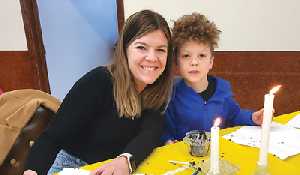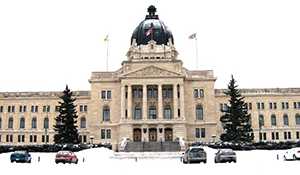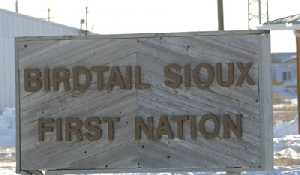SE Sask Firefighters helping with northern fires
July 21, 2015, 2:03 am
Julia Dima


Wildfires continue to burn across Northern Saskatchewan, threatening wildlife, cabins, and homes, and forcing thousands to evacuate to southern communities. Firefighters are overwhelmed, and asking for help from firefighters, volunteers, and now the Canadian Army reservists.
The Saskatchewan Volunteer Firefighters Association has been reaching out to fire departments across the province to lend equipment and services to help battle the fires.
The call has prompted Southeast Saskatchewan firefighters to pack their trucks and head up north. Carlyle fire chief Trent Lee, Redvers fire chief Brad Hutton, and firefighters Eric Brown, Andrew Hamilton, and Dwayne Henderson of those departments answered the call, and spent six days helping battle back fires around the village of Weyakwin, located 95 kilometres south of La Ronge.
“They were looking for assistance, and they gave us a call to go up and do some value protection around the big wildfires,” says Lee. “Part of value protection is making sure any of the hot spots around the villages and communities where we are working are taken care of to prevent any spread to structures.”
Going up north to help out was a no-brainer for the crew.
“It doesn’t matter where we’re doing it, the mentality is people need help, let’s go out and help them. It doesn’t matter if it’s our community or someone else’s if the call is out there that there is an emergency and help is required, it’s the right thing to do,” Lee says. “We always say that if we need help here, we’re going to want people coming to help us.”
Because they were stationed to prevent structure damage and to extinguish spot fires, Lee says the work was similar to what the fire department does back home in the Carlyle area, putting out grass and shrub fires, as well as structural fires.
However, the extent of the fires was something Lee, Hutton, and the rest of the crew, had never had to contend with before.
“A lot of the fires we saw were really thick black smoke, that turned to white and would take over the whole sky. The flames could be quite high over the treeline and spreading extremely fast,” Lee says.
Upon arrival, Lee says the scene near Weyakwin was overwhelming.
“There were all kinds of people and equipment, helicopters dropping water and very thick heavy smoke. We saw water bombers flying over, it was pretty intense there for a little while, way different from what we’re accustomed to down here,” he says.
Hutton says that driving past burned rubble and empty communities was disheartening.
“It was a pretty dull and depressing looking area—driving in was all burned out and black, and then when you get in, there’s a completely evacuated reserve and resort community, and all you could smell was burned wood and smoke the whole time,” he says.
On their first day, the firefighters spent the time patrolling around the edge of the village and putting out any hot spots that could endanger property, and running a sprinkler system around the edge of the village to keep everything wet and prevent it from catching fire. Afterwards, they began traveling along the roads and highway and extinguishing every hot spot they came across in the bush. The hot and dry conditions paired with the age of the old forest around Weyakwin creates challenges in keeping the fires out.
“It was an old forest that had never been burned, so the buildup of old wood on the forest floor kept smouldering,” Hutton says.
“We put out countless fires—I can’t imagine how many,” adds Lee. “You’d go to one spot fire, come back, and on your way back, you’d come across one that wasn’t there when you drove by 20 minutes before. They would flare up out of nowhere.”
Neither Hutton nor Lee ever felt like they were in danger during their time up north. They had to be cautious to look out for falling burning trees overhead, as a tree had fallen on a firefighter in the region before they arrived. The spot fires they were extinguishing were controllable, and Lee says if there was a point where they felt unsafe, the wildfire team would send in a helicopter to put out larger fires.
“We knew from our morning debriefing that there were experienced and well-trained people there. It was a good situation to be part of—one of those situations where everything clicked,” Lee says. “There was absolutely fantastic teamwork among ourselves too, we never had to tell each other what to do, we just had that special click and pulled onto a spot fire, and someone was automatically on the nozzle and someone firing the pump.”
Despite the good experience of fighting the fires together as a crew, watching the north burn was disheartening for the crew.
“It’s devastating to see because it’s such a loss, such a waste—there’s all these trees and habitats lost, and you think about the animals as well, you wonder where all the animals go and if they are burned and killed in the fire, or if they got out. You can never know,” Hutton says.
Lee says he feels good knowing that he was able to protect the homes of the people of Weyakwin, who were all forced to evacuate.
“It’s been devastating to the locals up there and the people who have to deal with that on a daily basis. The devastation is unreal—it’s widespread and affecting a lot of people, even just to be evacuated for that amount of time is quite stressful for the people who live there,” he says.
The crew was sent home when it was clear that Weyakwin was safe from fires. But if the call came again, Lee, Hutton, and their crew of volunteers say they would be ready to pack the truck again and hit the road.
“We would go back no questions asked, absolutely,” Lee says. “It was definitely something I’d like to go back to and experience again, get some more experience under our belts and help the guys out.”



































